

Jurassic. Etymology[edit] The chronostratigraphic term "Jurassic" is directly linked to the Jura Mountains.
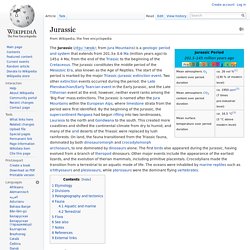
Alexander von Humboldt recognized the mainly limestone dominated mountain range of the Jura Mountains as a separate formation that had not been included in the established stratigraphic system defined by Abraham Gottlob Werner, and he named it "Jurakalk" in 1795.[4][5][6][7] The name "Jura" is derived from the Celtic root "jor", which was Latinised into "juria", meaning forest (i.e., "Jura" is forest mountains).[5][6][8] Divisions[edit] Key events in the Jurassic An approximate timescale of key Jurassic events.
Toarcian turnover.
Middle Jurassic. Late Jurassic. Triassic–Jurassic extinction event. Millions of years ago Tr–J The blue graph shows the apparent percentage (not the absolute number) of marine animalgenera becoming extinct during any given time interval.
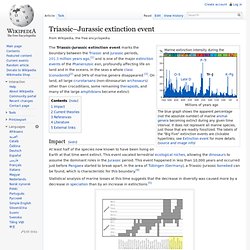
It does not represent all marine species, just those that are readily fossilized. The labels of the "Big Five" extinction events are clickable hyperlinks; see Extinction event for more details. (source and image info) Impact[edit] At least half of the species now known to have been living on Earth at that time went extinct. Statistical analysis of marine losses at this time suggests that the decrease in diversity was caused more by a decrease in speciation than by an increase in extinctions.[5] Ranges of families tetrapods through the Triassic and Early Jurassic.
Current theories[edit] Several explanations for this event have been suggested, but all have unanswered challenges: References[edit] Literature[edit] Hodych, J. External links[edit] Bird. Modern birds are characterised by feathers, a beak with no teeth, the laying of hard-shelled eggs, a high metabolic rate, a four-chambered heart, and a lightweight but strong skeleton.
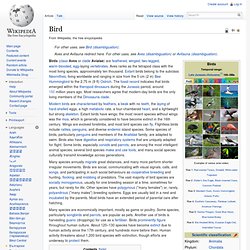
Extant birds have wings; the most recent species without wings was the moa, which is generally considered to have become extinct in the 16th century. Wings are evolved forelimbs, and most bird species can fly. Flightless birds include ratites, penguins, and diverse endemic island species. Some species of birds, particularly penguins and members of the Anatidae family, are adapted to swim. Birds also have digestive and respiratory systems that are uniquely adapted for flight. Many species are economically important, mostly as game or poultry. Evolution and classification Definition. Theropoda. Biology[edit] Diet[edit] Theropods exhibit a wide range of diets, from insectivores to herbivores and carnivores. Strict carnivory has always been considered the ancestral diet for theropods as a group, and a wider variety of diets was historically considered a characteristic exclusive to the avian theropods (birds).
However, discoveries in the late 20th and early 21st centuries showed that a variety of diets existed even in more basal lineages.[1] All early finds of theropod fossils showed them to be primarily carnivorous. Fossilized specimens of early theropods known to scientists in the 19th and early 20th centuries all possessed sharp teeth with serrated edges for cutting flesh, and some specimens even showed direct evidence of predatory behavior.
Pterosaur. Pterosaurs are often referred to in the popular media and by the general public as flying dinosaurs, but this is incorrect.

The term "dinosaur" is restricted to just those reptiles descended from the last common ancestor of the groups Saurischia and Ornithischia (clade Dinosauria, which includes birds), and current scientific consensus is that this group excludes the pterosaurs, as well as the various groups of extinct marine reptiles, such as ichthyosaurs, plesiosaurs, and mosasaurs.[7] (Like the dinosaurs, and unlike these other reptiles, pterosaurs are more closely related to birds than to any living reptile.)
Plesiosauria. Plesiosaurs were among the first fossil reptiles discovered.
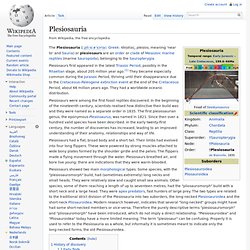
In the beginning of the nineteenth century, scientists realised how distinctive their build was and they were named as a separate order in 1835. The first plesiosaurian genus, the eponymous Plesiosaurus, was named in 1821. Since then over a hundred valid species have been described. In the early twenty-first century, the number of discoveries has increased, leading to an improved understanding of their anatomy, relationships and way of life.
Plesiosaurs had a flat, broad body and a short tail. Ichthyosaur. Ichthyosaurs (Greek for "fish lizard" - ιχθυς or ichthys meaning "fish" and σαυρος or sauros meaning "lizard") were large marine reptiles.
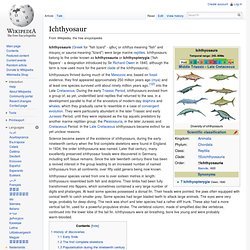
Ichthyosaurs belong to the order known as Ichthyosauria or Ichthyopterygia ('fish flippers' - a designation introduced by Sir Richard Owen in 1840, although the term is now used more for the parent clade of the Ichthyosauria). Science became aware of the existence of ichthyosaurs, during the early nineteenth century when the first complete skeletons were found in England.
In 1834, the order Ichthyosauria was named. Later that century, many excellently preserved ichthyosaur fossils were discovered in Germany, including soft tissue remains. Since the late twentieth century there has been a revived interest in the group leading to an increased number of named ichthyosaurs from all continents, over fifty valid genera being now known. Ichthyosaur species varied from one to over sixteen metres in length.